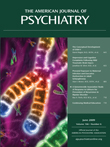To the Editor: There has been great interest in deriving a multidimensional model of obsessive-compulsive disorder (OCD) symptoms. Factor analyses have delineated the heterogeneous symptoms (as measured by the Yale-Brown Obsessive Compulsive Scale–Symptom Checklist) into three to six dimensions associated with separable patterns of comorbidity, treatment response, and neural correlates
(1) .
In the December 2008 issue of the
Journal, Michael H. Bloch, M.D., et al.
(2) presented a meta-analysis of 21 factor-analytic studies of OCD and reported the following four factors: 1) symmetry (symmetry obsessions and repeating, ordering, and counting compulsions); 2) forbidden thoughts (aggressive, sexual, religious, and somatic obsessions and checking compulsions); 3) cleaning (cleaning and contamination); and 4) hoarding (hoarding obsessions and compulsions). The authors noted that the meta-analysis was limited by the use of category-level data rather than item-level (symptom) data from the Yale-Brown Obsessive Compulsive Scale–Symptom Checklist. Category-level factor analyses are problematic, since they assume the validity of the symptom groupings, restrict the number of items available for analysis, and limit the symptom dimensions that can emerge. An item-level confirmatory factor analysis
(3) failed to empirically support the Yale-Brown Obsessive Compulsive Scale–Symptom Checklist categories, given the heterogeneity within certain checklist categories. In particular, the aggressive obsessions category includes items that target fear of aggressive impulses as well as over-responsibility for harm. Dr. Bloch et al. recommended item-level studies to clarify the relationship between the aggressive obsessions items and the sexual, religious, somatic, and checking categories.
Two recently published item-level studies, one with 485 subjects
(4) and one with 398 subjects
(5), addressed this issue. Applying novel statistical methods, five similar factors were derived in both of these studies (e.g., symmetry/ordering; hoarding; doubt/checking; contamination/cleaning; and taboo thoughts [aggressive, sexual, religious obsessions]
[4] ). Also in both studies, fear of aggressive impulse items loaded with the other “taboo” obsessions, while the over-responsibility for harm items loaded with checking compulsions. This separation of the a priori aggressive obsessions category was previously reported in an exploratory factor analysis
(6) . Although they share variance, the taboo thoughts and doubt/checking factors represent differentiable phenomena that are more homogeneous than the corresponding combined aggressive/sexual/religious/somatic/checking factor reported in the meta-analysis conducted by Dr. Bloch et al. Differentiating these components may further help decrease the phenotypic heterogeneity of OCD in the hope of making gains in conceptualization, pathophysiology, and treatment of this disorder.

